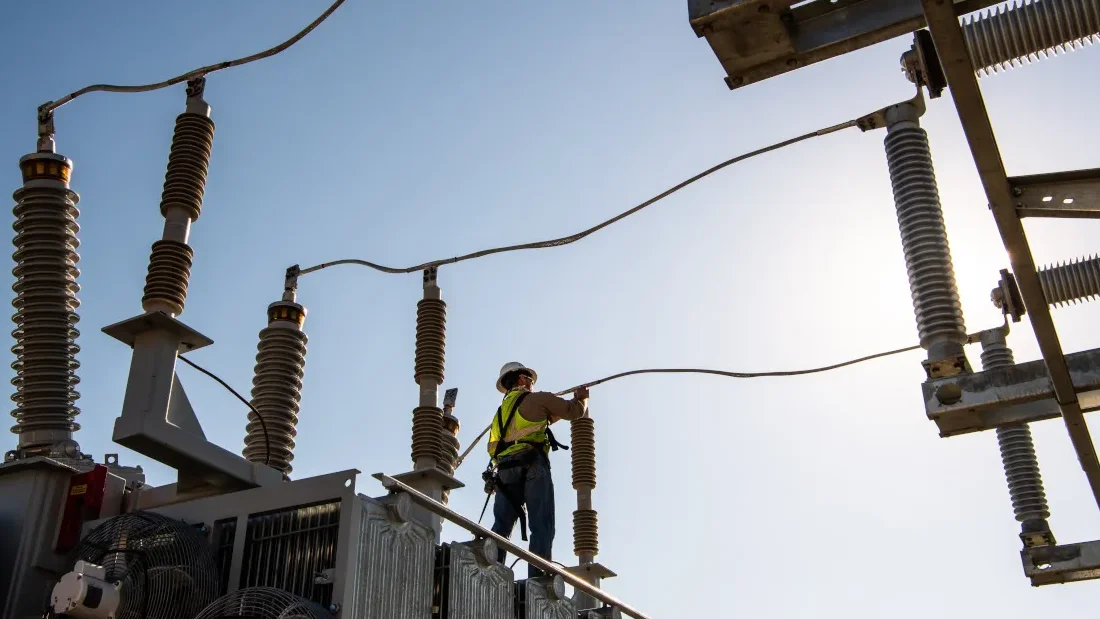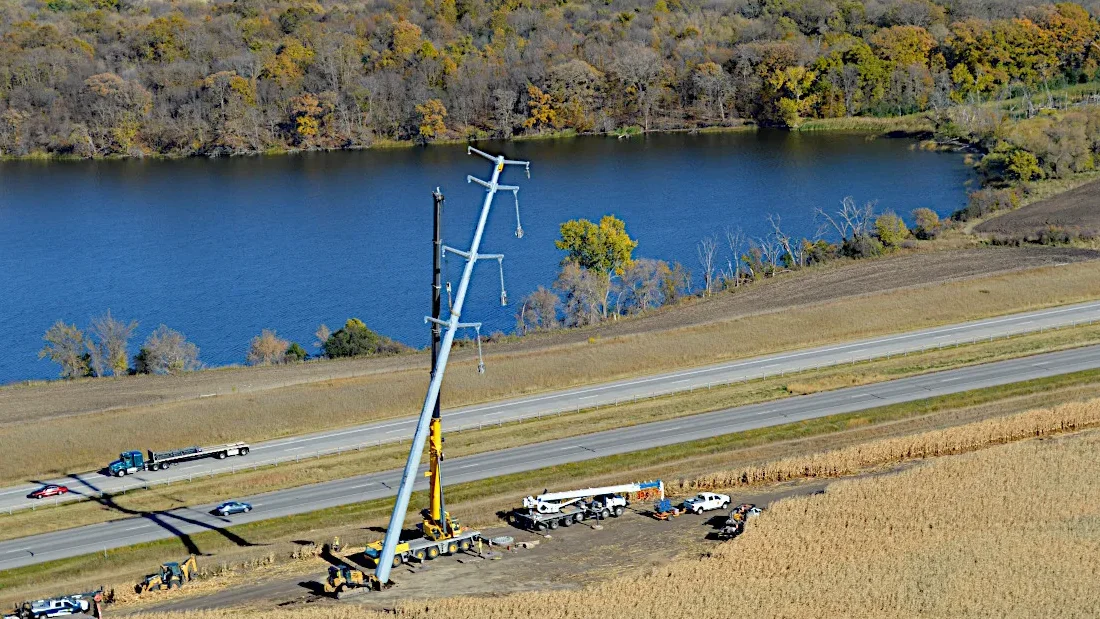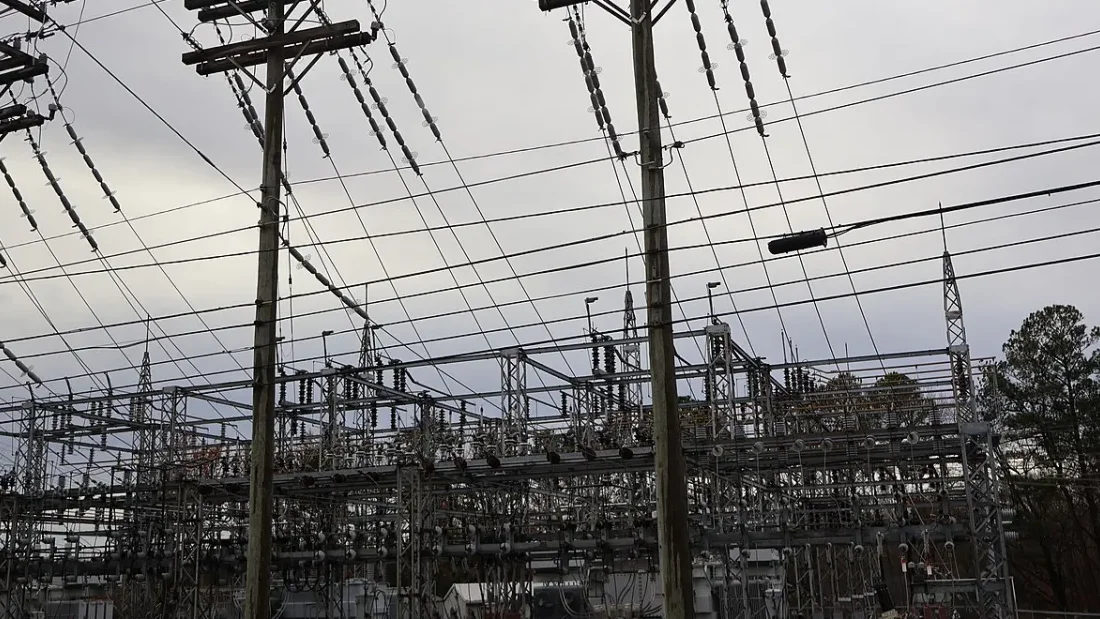
GRID: California’s grid operator proposes $6.1 billion in transmission projects aimed at increasing reliability and providing access to solar, geothermal and wind resources in Arizona, Nevada, New Mexico and offshore. (Utility Dive)
ALSO:
UTILITIES: Arizona advocates campaign for positions on a Salt River Project’s board with hopes of prodding the Phoenix-area utility to adopt more clean energy generation. (Capital & Main)
SOLAR:
CLEAN ENERGY: Idaho lawmakers pass a resolution supporting clean energy technologies such as green hydrogen production and advanced nuclear reactors. (KMVT)
NUCLEAR: Bill Gates-backed TerraPower applies for a federal permit to construct a proposed 345 MW sodium-cooled nuclear reactor in a Wyoming coal town. (World Nuclear News)
HYDROPOWER: An Arizona utility moves forward with a proposed 1,000 to 2,000 MW pumped hydropower energy storage project outside Phoenix, but predicts construction wouldn’t begin until 2027. (KJZZ)
ELECTRIC VEHICLES: Colorado launches the nation’s first statewide electric bicycle tax credit giving residents a $450 discount at the point of sale. (CBS News)
OIL & GAS:
CLIMATE:

POWER PLANTS: As economic growth drives new electricity demand, utilities such as Georgia Power look to natural gas as a quick fix, but customers and clean energy advocates say the strategy lacks ambition and ignores the giant pool of federal money currently available for cleaner alternatives. (Grist/WABE)
ALSO: A new report urges state regulators to be skeptical about “a panicked rush” to build new gas plants and says utilities could mitigate near-term load growth with a myriad of tech and policy solutions. (Latitude Media)
GRID: Software and smart meters are unlocking new potential for price-based demand response — using variable rates to change customer behavior — with Georgia Power and Entergy Louisiana among the utilities exploring the concept as a way to manage loads. (Utility Dive)
ELECTRIC VEHICLES: The shift to electric vehicles in North Carolina is happening faster than state officials anticipated, with electric vehicle registrations surpassing a state goal two years ahead of schedule with more than 80,000 on the road. (WRAL)
SOLAR: The developer of a Virginia solar project informs county officials that it is withdrawing its application for a special use permit. (Farmville Herald)
COAL:
CLIMATE: Indoor farming offers producers steady growing conditions amid increasingly unpredictable weather, but their energy consumption represents a potential threat that could worsen climate change. (Washington Post)
COMMENTARY: Duke Energy’s proposed carbon plan in North Carolina ignores a 2030 emissions target, doubles down on fossil fuels, and leans too heavily on expensive, unproven technology, an advocacy group writes. (SELC)

The Maine House rejected a bill Wednesday that would direct regulators to explore performance-based ratemaking for Central Maine Power and Versant, which last year beat back a referendum to replace the companies with a consumer-owned model.
The House voted 75-67 against LD 2172, sponsored by Rep. Gerry Runte (D-York). Republicans largely opposed the legislation but a handful of Democrats also voted against it. The proposal then moved to the Senate on Thursday, where it was tabled, meaning it will be taken up at a later date.
Runte’s bill would require the Public Utilities Commission (PUC) to examine performance-based metrics that could be implemented for utilities and conduct that examination every three years thereafter. Generally speaking, performance-based ratemaking (PBR) creates specific benchmarks for utilities to meet. The utilities could then get rewarded if they meet the targets or be penalized if they don’t.
The performance of Maine’s primary investor-owned utilities, CMP and Versant, has been a frequent topic of discussion in recent years. The companies’ relative unpopularity with Mainers, frustration with their quality of service and concerns about their for-profit business model spurred the referendum last fall to replace CMP and Versant with a nonprofit, consumer-owned utility. However, Mainers voted down the measure amid a deluge of spending against the proposal.
During Wednesday’s debate in the House, Rep. Sophia Warren, a Democrat from Scarborough, argued there isn’t sufficient evidence that LD 2172 would benefit ratepayers and improve the utility system.
“We cannot with any guarantee know the outcome of this legislation, and I believe that is a potentially quite harmful consequence we must take seriously,” said Warren, adding that she would support a targeted study on PBR policies in Maine.
Warren — a critic of CMP and Versant who supported the referendum to replace the companies — also pushed back against proponents who have argued that the bill will hasten Maine’s clean energy transition. She said nothing in the legislation ties a utility’s performance to making the grid more sustainable.
Republican Rep. Steven Foster of Dexter also expressed opposition to the bill. Among other issues, Foster argued that some parts of the proposal are duplicative of a 2022 bill that requires the PUC to adopt rules for CMP and Versant. Specifically, the PUC was tasked under that law with creating quantitative metrics around service quality along with coming up with a report card to evaluate utilities.
Runte said LD 2172 is meant to build on that previous measure. And he added that if the state wants CMP and Versant to perform better, it needs to create rules that incentivize the companies to further Maine’s grid-related policy goals — which he argued is currently lacking.
“LD 2172 attempts to solve this problem by directing the PUC to begin a process to define how we want our utilities to perform in the 21st century, as well as consider modern models of utility regulation that better align a utility’s performance with these new goals,” he said.
Under Runte’s proposal, the PUC would have to establish goals and evaluate options for creating metrics to determine how well utilities meet certain criteria. In creating those goals, PUC would have to keep in mind the following: benefit to ratepayers, promotion of cost efficiency and affordability, increased planning for extreme weather and climate hazards, a comprehensive response to outages, and support of renewable resource and greenhouse gas reduction goals. The goals would also have to be consistent with the state’s climate action plan.
Runte said the process for coming up with goals for utilities to meet and metrics to evaluate them is kept deliberately flexible in the bill, giving appropriate latitude to the PUC to determine what will work best for Maine and to adjust policies as needed.
The bill would further require that the commission get input from various stakeholders, mandate that the PUC provide a summary of its performance-based ratemaking actions, task the organization with coming up with recommendations for forming a regulatory policy group within the commission, and require the PUC to implement emerging reforms if such changes better align with state goals.
Runte pointed out that 17 states have approved similar reforms, although Warren noted that just two states have moved to extensively implement PBR policies, and she argued the experience of one of those states — Connecticut — has not been positive.
But Rep. Valli Geiger (D-Rockland) said that although Mainers voted down the November referendum to replace CMP and Versant, that doesn’t mean they are happy with the service provided by the companies. She said implementing PBR would provide the state the tools to bring the utilities into alignment with important goals, particularly when it comes to the clean energy transition.
Both CMP and Versant have been tepid about the bill. During a committee hearing earlier this year, a representative from Versant said the company is willing to take initial steps toward performance-based ratemaking but called for the goals established by the PUC to be brought back to lawmakers for review. And CMP argued the time isn’t right for Runte’s bill because lawmakers should first see how recent regulations, like the 2022 bill, work out.

GRID: A Texas municipal utility builds four large solar farms and a natural gas-fired power plant as it aims to keep pace with power demand from data centers and electrification. (El Paso Times)
ALSO:
SOLAR:
ELECTRIC VEHICLES:
OIL & GAS:
COAL: An Alabama family sues for damages after a coal mine explodes because of what a lawyer blames on a buildup of methane gas. (Inside Climate News)
CLEAN ENERGY: A report finds Georgia ranks second in the U.S. for clean energy development with $23.12 billion in investment. (Augusta Chronicle)
POLITICS: Virginia lawmakers use a budget amendment to try to force the state to rejoin a regional carbon market, but it will likely be vetoed by Gov. Glenn Youngkin. (Inside Climate News)
CLIMATE:
COMMENTARY:

GRID: National Grid announces a $4 billion plan to upgrade its upstate New York power grid, with new substations and rebuilt power lines among its 6-year plan. (Utility Dive)
ALSO: Several hundred thousand New England residents lost power during severe storms over the weekend, and more than 100,000 remained in the dark Monday morning. (NBC Boston, WMTW)
OFFSHORE WIND:
UTILITIES:
POLICY:
SOLAR: Westmoreland County, Pennsylvania’s housing authority seeks county funding to help build a solar farm that could power a low-income senior apartment complex and other county facilities. (TribLive)
CLEAN ENERGY: The Massachusetts Clean Energy Center awards $2.5 million for projects across the state, including a solar panel recycling project and a biogas production system. (Worcester Business Journal)
HYDROGEN:
ELECTRIC VEHICLES: Rhode Island considers replacing its gas tax with a mileage-based user fee to combat an expected drop in revenue as electric vehicles replace combustion cars. (EcoRI)
CLIMATE: Maryland’s chief resilience officer says climate issues pose the biggest challenge to the state’s stability, with rising floods, worsening storms and growing heat among his biggest concerns. (Inside Climate News)
COMMENTARY:

GRID: The Biden administration is expected to unveil a grid expansion plan this spring, but experts say the president would need at least a second term to fully roll out the transmission buildout. (E&E News)
ALSO: U.S. lawmakers introduce legislation that would require federal energy regulators to establish incentives for transmission owners to add grid-enhancing technologies to existing power lines. (Utility Dive)
ELECTRIC VEHICLES: The Biden administration plans to unveil a clean car rule next week that would require carmakers to cut average vehicles emissions 52% by 2032, likely spurring electric vehicle production. (Politico)
OFFSHORE WIND:
HYDROGEN: The U.S. Energy Department announces that it will funnel $750 million in bipartisan infrastructure funding to electrolyzer research and development projects, with a goal of spurring clean hydrogen. (E&E News)
COAL: Fourteen coal plants closed in the U.S. last year, but power generators are largely looking to natural gas to replace that capacity. (Inside Climate News)
CLIMATE:
UTILITIES: The role of a decayed power pole in sparking this month’s historic Texas wildfires drives discussion about the state’s general lack of regulations for utilities related to wildfire mitigation. (NPR, Houston Chronicle)
SOLAR:
PIPELINES: A four-week trial ends in North Dakota in a case to determine whether the state or federal government should pay $38 million in policing costs for Dakota Access pipeline protests, though a judgment isn’t expected for weeks. (North Dakota Monitor)
FOSSIL FUELS: A development group finishes dismantling a former oil refinery in south Philadelphia, once the East Coast’s largest such facility, and begins construction on an industrial space and life sciences lab. (Philadelphia Inquirer)
EFFICIENCY: A Virginia company offers a free online calculator to help homeowners navigate federal tax credits and point-of-sale rebates for efficient appliances. (Energy News Network)
BIOMASS: Environmental groups are concerned that the federal Inflation Reduction Act could create tax incentives for wood-to-energy biomass projects and potentially worsen climate emissions. (Inside Climate News)

GRID: An analysis finds Texas has experienced 263 power outages since 2019, the most of any state in the country, indicating its power grid is struggling under demand and extreme weather. (Houston Chronicle)
ALSO:
ELECTRIC VEHICLES:
STORAGE: Texas residents are worried about a developer’s plans to build a battery storage facility near a neighborhood and elementary school. (KTRK)
OIL & GAS:
COAL:
CLIMATE:
UTILITIES: Austin, Texas’ municipal utility pauses the process of reworking its resource, generation and climate plan while the mayor pushes to divest from a coal-fired power plant and environmentalists call for more renewables. (Austin Monitor)
GEOTHERMAL: A student team from the University of Oklahoma wins a competition for its design of geothermal wells to heat a 40,000-square-foot greenhouse operated by the Osage Nation. (KWTV/KSBI)
MINING: A Virginia company moves to reopen critical minerals mining and production facilities in the state, after having previously discontinued operations there in 2015. (Virginia Mercury)
COMMENTARY:

ELECTRIFICATION: The Biden administration awards a northwest Alaska borough $50 million to install electric heat pumps in every home and to build solar installations to power them. (Northern Journal)
OIL & GAS:
MINING:
POLLUTION: Dozens of oil and gas industry and environmental group lobbyists work to influence Colorado lawmakers as they consider legislation aimed at reducing ground-level ozone pollution. (CPR)
SOLAR:
UTILITIES:
ELECTRIC VEHICLES: California says it has surpassed 100,000 public or shared private electric vehicle chargers throughout the state. (news release)
TRANSPORTATION: The Biden administration pours funding into a proposed high-speed passenger rail line linking Las Vegas and Los Angeles in hopes it will spark a national rail revolution. (Los Angeles Times)
CLIMATE:
BIOFUELS: The Biden administration awards $30 million to a cluster of California projects aimed at converting forest cuttings into biofuels. (Bioenergy Insight)

The Midwest’s regional transmission grid operator this week announced another multi-billion dollar phase of transmission line projects as part of a four-part push to improve reliability and reduce curtailments.
The Midcontinent Independent System Operator (MISO) unveiled plans Monday for what’s known as its “Tranche 2” portfolio, which includes plans for several 765 kilovolt transmission “highways” spanning sections of Minnesota, Iowa, Wisconsin, Illinois, Indiana, Michigan, North Dakota and Missouri.
Many of the new lines would connect to projects being built as part of the $10.4 billion Tranche 1 portfolio, which MISO approved last year. Tranche 2 is projected to cost even more, at between $17 billion and $23 billion. A third batch of projects will focus on the grid operator’s southern territory, and the fourth will address north-south connections.
In its presentation to stakeholders, MISO officials said the investment will help manage challenges in three regions. In MISO West, which includes Minnesota, Iowa, North Dakota, Wisconsin and Michigan’s Upper Peninsula, 20% of its facilities are overloaded and annual curtailments exceed 15%.
In its Central region, composed of parts of Illinois, Indiana, and Missouri, facilities are 10% overloaded, and there’s a need for transmission to move power from west to east.
MISO’s East Region, defined as Michigan’s lower peninsula, suffers annual curtailment of over 15% and 10% of facilities are overloaded. MISO said in a presentation that transmission would help mitigate “import and export power swings between day and night.”
Beth Soholt, executive director of the nonprofit Clean Grid Alliance, said the Tranche 2 plan is “bold” and “the direction we need to go.” The question is: does it go far enough?
The regional grid is expected to see significant growth from industries, electrification, data centers and other sources, Soholt said.
“If load growth ramps up faster than the grid can handle, then we’re behind the eight ball again,” she said. “Now is the time to ask: Have we right-sized this portfolio?”
Mike Schowalter, senior manager of wholesale electric grid transition for Fresh Energy, said he was surprised by the lack of a High Voltage Direct Current (HVDC) line.
“If we’re looking at the long-term, we’re going to need the attributes that HVDC brings,” Schowalter said.
The Energy News Network is an independent journalism program of Fresh Energy.
A 765 kV transmission line needs taller towers and a much wider corridor than HVDC or other alternatives, Schowalter said.
“I’m a little concerned about some of the siting issues that the different states will have to deal with,” he said, noting that the map shows a 765 kV Minnesota River crossing.
Utilities have told Schowalter that the plan misses future pockets of generation that may need additional transmission. He said the reason may be because the draft report centers on reliability, not interconnection constraints.
The plan also does not venture much into North Dakota, which has plenty of wind generation, Schowalter said. The draft plan “will help with some congestion, but will it help enough?” he said. “Probably not. In terms of relative to what we need, we need a lot more than this.”
Some utilities also think deploying HVDC lines would better solve grid instability issues, especially between wind-rich Southwest Minnesota and the more populated regions to the east, Soholt said. HVDC transmits electricity more efficiently than alternate current lines, which have higher rates of power loss.
Utilities have often had to curtail wind power from southwest Minnesota because of transmission capacity issues. Clean energy advocates and others will be closely listening to the business case MISO will make later for the choice of the transmission locations and the size of the lines, she said.
Soholt said comments are being taken now on the plan and some stakeholders will offer modifications and alternatives. Some clean energy developers and members of the Clean Grid Alliance plan to suggest alternatives. Some organizations are expected to argue that MISO does not need this much transmission and others will tender a different vision, she said.
So far, MISO has released only a rough map of where the lines would run, without much detail. A stakeholder process will refine precisely where the lines will operate, Soholt said.
Stakeholder input and alternatives to the Tranche 2 plan will be accepted through April 5. MISO will make a final decision later this year.

GRID: Some observers question if New York will have enough power on its grid to support the expansion of a semiconductor manufacturer’s capacity, a development that just received significant federal funding. (Times Union)
ALSO: An advanced energy trade group issues a report card giving low marks to PJM Interconnection and ISO New England for their overall interconnection processes, including regional transmission planning. (Utility Dive)
OFFSHORE WIND:
BUILDINGS:
GAS: Although the investigation is still ongoing, federal investigators have released dozens of documents and photos related to a gas explosion at a West Reading, Pennsylvania chocolate factory last March. (Daily Times)
PIPELINES: Some residents of Burrillville, Rhode Island, want state officials to extend a public comment period and hold a hearing as they work to get the operating air permit renewal rejected for Enbridge’s Algonquin pipeline. (ecoRI)
ELECTRIC VEHICLES:
FLOODS: The financial toll of the floods that swept through some central Massachusetts towns last September is still hitting residents and municipal officials, with federal officials rejecting a request for disaster relief. (Boston Globe)
SOLAR: A central Pennsylvania church installs a $75,000 solar array that completely offsets its energy needs, a project the pastor says is necessary to address “the biggest problem of our age.” (WFMZ)